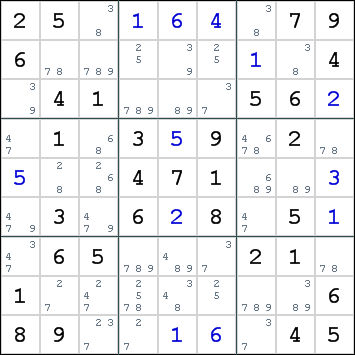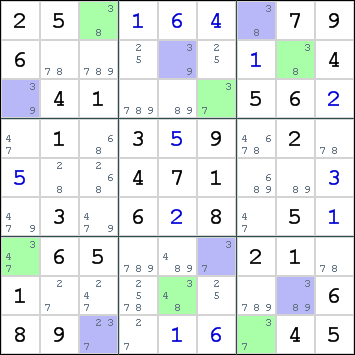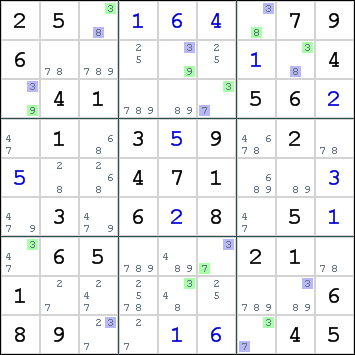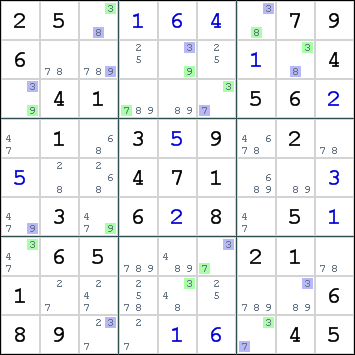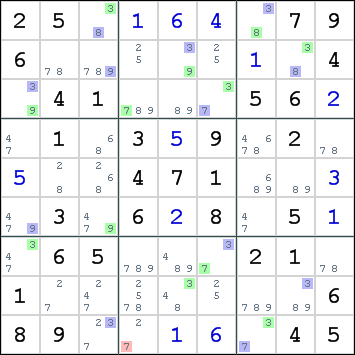3D Medusa
3D Medusa or Advanced Coloring is a coloring technique which considers multiple digits.
When the technique is limited to a single cluster, you can also replicate its effects by placing Equivalence Marks in the pencilmark grid, making it a good advanced technique for pencil and paper solvers.
When multiple clusters are used, this technique allows you to locate every candidate-to-candidate chain in the grid.
Contents
How it works
3D Medusa expands the rules for Simple Colors and Multi-Colors to include multiple digits. When you apply colors to the candidates for a single digit, you are working in a 2-dimensional plane of 9 rows by 9 columns. To see the 3-dimensional picture, think of each digit's plane as a layer in a 3D cube. Since there are 9 digits, there are 9 layers in this cube. When there are only 2 candidates in a line in any of the 3 dimensions, you can give them opposite colors, building clusters as you would do in 2D coloring.
Because it is a little far-fetched to turn every Sudoku into a 3D model, there are a few simple rules that allow you to perform this technique in a 2-dimensional pencilmark grid.
Choose a starting digit
Because you should try regular coloring before 3D coloring, you must already have some idea about the coloring possibilities for each digit. To select the best starting digit, pick a digit that has 2 or more conjugate pairs, and several of its candidates are located in bivalue cells. These bivalue cells allow you to expand the coloring clusters beyond the single digit boundary.
Here is a pencilmarked grid that has no more basic solving techniques:
For this grid, the starting digit is an easy choice, looking at the pattern for digit 3. All remaining candidates form a single cluster, and there are 8 bivalue cells in the cluster, giving us ample opportunity to expand the cluster to other digits.
Create a color cluster for the starting digit
Do this the same way you would for simple coloring. Take a conjugate pair and use opposite colors to mark parity. Grow the cluster by adding additional candidates which are connected to it with a conjugate pair. Make sure that both ends in each pair have opposite parities.
In our example, it is not too difficult to color this cluster:
Mark opposite parities in bivalue cells
Check your cluster to see if there are bivalue cells where only one of the candidates is colored. For each one you find, color the second candidate with the opposite color.
In our example, we have to switch from coloring entire cells to coloring individual candidates within a cell. All candidates for digit 3 that have a particular parity have the same color, but now we have used the complementary color for all bivalue cells that contain a colored digit:
For the purpose of this example, we will continue coloring the remaining digits. However, in this stage you could already see something peculiar...
Expand the cluster for the newly added digits
For each candidate added in the previous step, check the remaining candidates for that digit. If the candidate you're checking is part of one or more conjugate pairs containing any recently added candidates, expand your cluster by coloring the candidate you're checking with the opposite color from that of the recently added candidate. Continue coloring for each digit until no more candidates can be added.
In our example, we've added candidates for digits 7, 8 & 9 in the previous step. After expanding the cluster with conjugate pairs for these digits, we get this cluster:
Repeat the last 2 steps until finished
Now see if the last step has added new bivalue cells to the cluster. If so, repeat the last 2 steps until no more additions can be made.
Since no new bivalue cells were added in the last step, we are finished with this stage of the example.
Analyze the cluster
Now you can analyze the results. The first check is to see whether the cluster contains a contradiction:
- 2 candidates in a single cell have the same color.
- 2 candidates for a single digit in a single house have the same color.
When a contradiction is found for a particular color, you can place all candidates with the opposite color into their cells.
The next check is to see whether there are any candidates that can see both colors of the cluster:
- 2 colors appear in a single multivalued cell. The uncolored candidates can be eliminated.
- An uncolored candidate X can see two differently colored X. The uncolored candidate can be eliminated
- An uncolored candidate can see a cell where the same digit is colored, while its own cell has another candidate with the opposite color. The uncolored candidate can be eliminated.
The last type of elimination is only possible in 3D coloring.
In our example, the candidate for digit 7 in r9c4 can see both colors:
We can therefore eliminate digit 7 from this cell, which allows us to place the remaining digit 2.
7 can also be eliminated from r7c9 since it can see a green 7 in r7c6 and a blue 7 in r9c7
